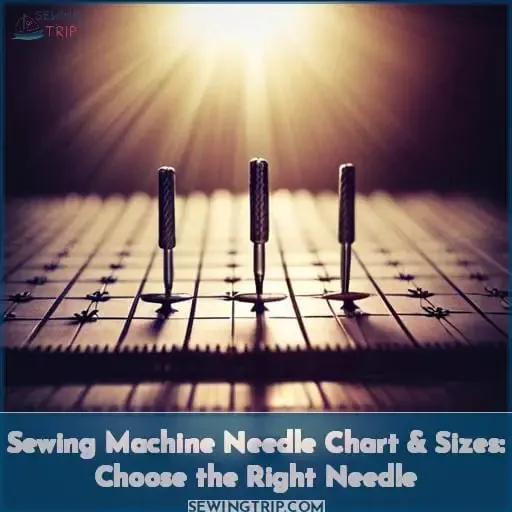
This site is supported by our readers. We may earn a commission, at no cost to you, if you purchase through links.

Ready to master the art of choosing the right sewing machine needle? Look no further than our Sewing Machine Needle Chart & Sizes guide.
With this handy chart, you’ll be able to navigate through the different types and sizes of needles with ease.
Say goodbye to skipped stitches and fabric damage – it’s time to take control of your sewing projects like a pro!
Table Of Contents
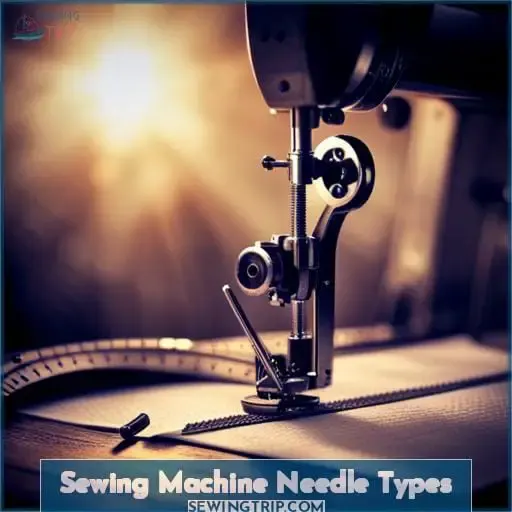
Let’s talk about the different types of sewing machine needles.
Universal needles are great for all kinds of fabrics.
Ball point needles work best on knits and stretch fabrics to prevent puckering.
Stretch needles, on the other hand, are specifically designed for sewing stretchy materials like Lycra or Spandex.
Sharps needles are perfect for woven fabrics to prevent fraying, and quilting needles have a longer shaft and sharp point that help with quilting projects.
When choosing the right sewing machine needle for your project, consider using universal needles.
They’re versatile and can be used for knits, leather, silk, denim, and wool fabrics.
To sew through knits and other stretch fabrics, you’ll need a ball point needle. This type of needle has a rounded tip that prevents the fabric from puckering.
| Needle Type | Best for |
|---|---|
| Ball Point | Knits, stretch fabrics |
Choose stretch needles when sewing with Lycra or Spandex fabrics to prevent them from stretching out of shape.
They’ve a sharp point and wider shaft, ideal for preventing fabric distortion.
For the best results in sewing through woven fabrics, use Sharps needles.
These needles have a sharp point to prevent fraying.
Remember to choose the right size and replace your needle regularly for optimal performance and care.
When quilting, choose the right needle type to achieve optimal results and prevent fabric puckering or distortion.
Quilting needles come in various types, sizes, and brands for replacement or maintenance purposes.
Consider factors such as:
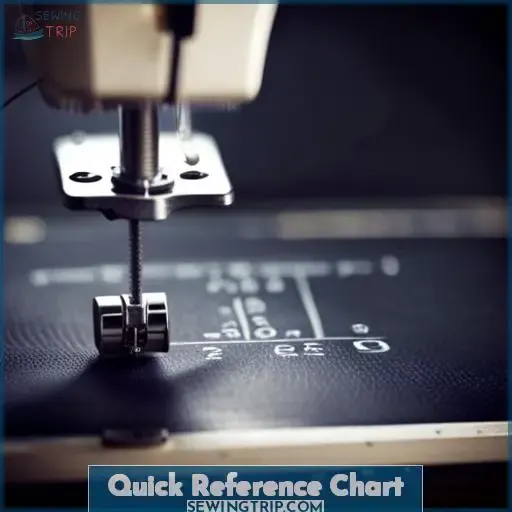
To quickly determine the appropriate sewing machine needle for your project, refer to this easy-to-use chart that outlines different needle types and sizes based on fabric thickness:
Now let’s talk about needle sizes – use a size 60 needle for silk, size 70 needle for cotton, and size 80 needle when working with denim or heavyweight fabrics.
By referring to this quick reference chart before starting your next project, you can confidently choose the right type and size of sewing machine needle needed to achieve professional results every time!
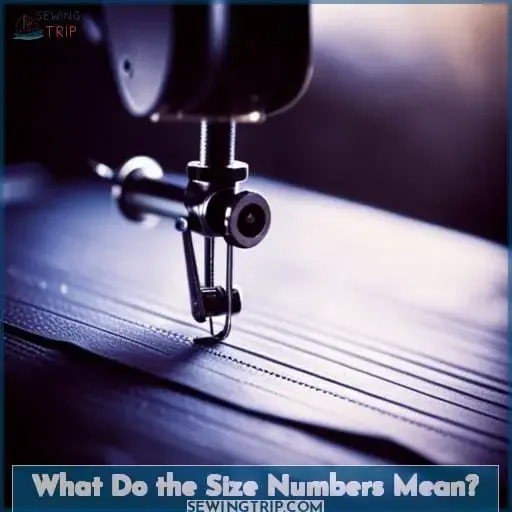
The size numbers on sewing machine needles indicate the diameter of the needle. Understanding these numbers is essential for choosing the right needle for your project.
Sewing machine needles come in various sizes, ranging from smaller to larger diameters.
To make it easier to compare and convert different sizing systems, you can refer to a needle size chart or use a handy conversion tool. These resources will help you find equivalents between European and American sizing.
By knowing how to read and interpret these size numbers, you gain more power over your sewing projects and achieve better results with different fabric types. Whether you’re working with lightweight fabrics that require a smaller needle or heavyweight materials that need a larger one, understanding needle sizes allows for greater precision in your stitching.
So take control of your sewing journey by familiarizing yourself with these important measurements!
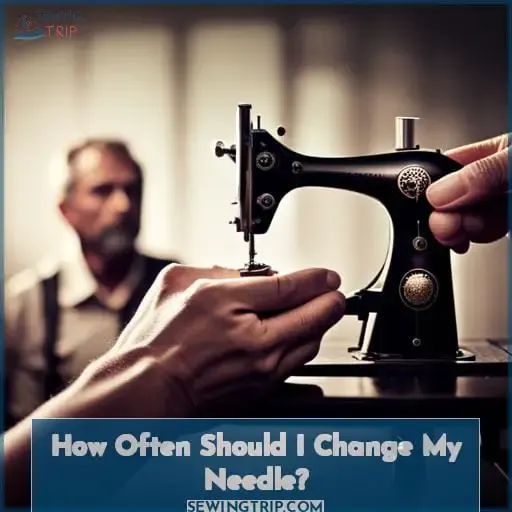
You should change your sewing machine needle after every project or if you notice any bending, damage, or jamming.
Regularly changing your needle is important to maintain the quality of your stitches and prevent any potential damage to your fabric.
Here’s how often you should change your needle:
By following these guidelines on how often to change your sewing machine needle, you’ll be able to achieve optimal results with each new project while prolonging the lifespan of your machine needles.
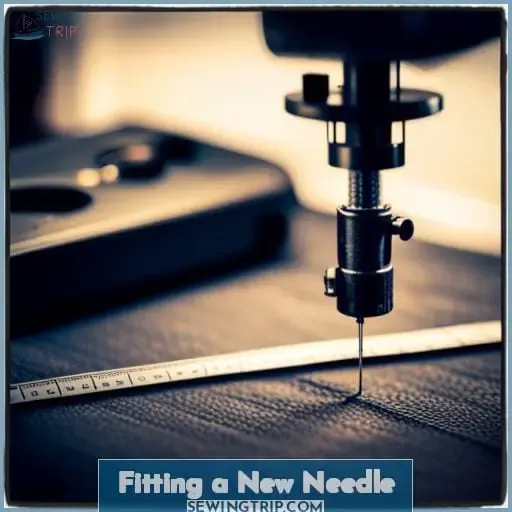
When fitting a new needle, start by placing a piece of paper under the foot before loosening the needle screw.
To insert the new needle, ensure that you have identified which side is flat on the shank and position it facing towards the rear of your sewing machine. Push it up as far as it can go before tightening the needle screw securely to hold it in place.
It’s important to pay attention to proper fitting when replacing your sewing machine needles. The correct insertion ensures smooth stitching and prevents any potential damage or issues with your fabric.
Take note of both size and type when selecting a replacement needle for optimal performance.
By following these steps for fitting a new needle, you’ll be able to maintain control over your sewing projects and achieve professional-looking results every time.
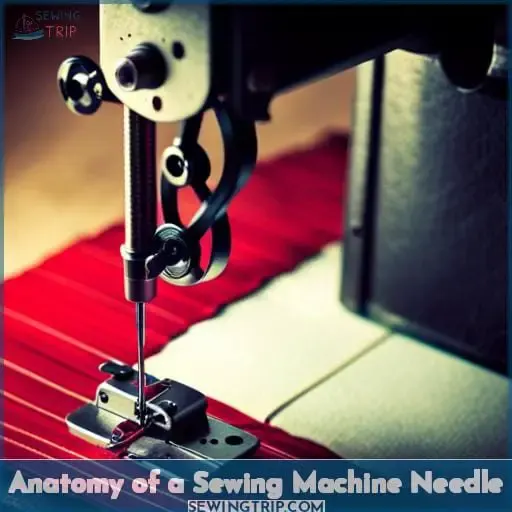
Now that you know how to fit a new needle, let’s take a closer look at the anatomy of a sewing machine needle.
Understanding the different parts of a needle can help you make informed decisions when choosing the right one for your project.
By understanding these sewing machine needle parts, you’ll have more control over selecting needles based on their sizes and types.
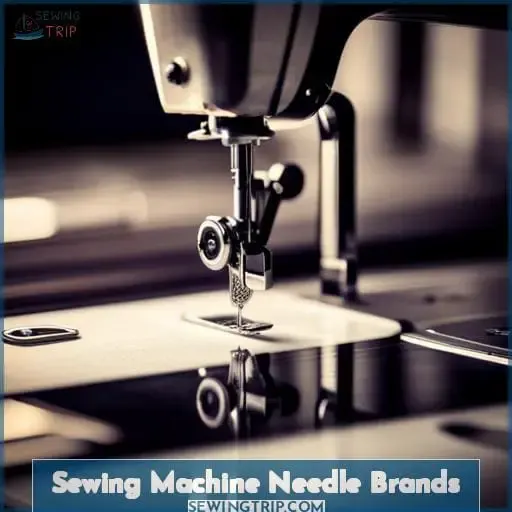
Continuing with our exploration of sewing machine needles, let’s delve into the world of sewing machine needle brands and discover which ones are considered reliable and reputable for your stitching needs.
When it comes to choosing a brand you can trust, there are several top contenders in the market. Singer is a well-known name in the industry, offering a range of high-quality needles suitable for various fabrics.
Schmetz is another popular brand known for its durability and precision. Pfaff, Janome, and Brother also offer their own lines of sewing machine needles that have been praised by experts in the field.
Whether you’re working on lightweight or heavyweight fabrics, these brands provide options that cater to different needs. From universal needles to ballpoint needles designed specifically for knits and stretch fabrics, you’ll find an array of choices within each brand’s offerings.
When selecting your needle size from these trusted brands’ ranges (which can typically be found on a handy chart), keep in mind factors such as fabric thickness and project requirements—choosing correctly will ensure smooth stitches every time.
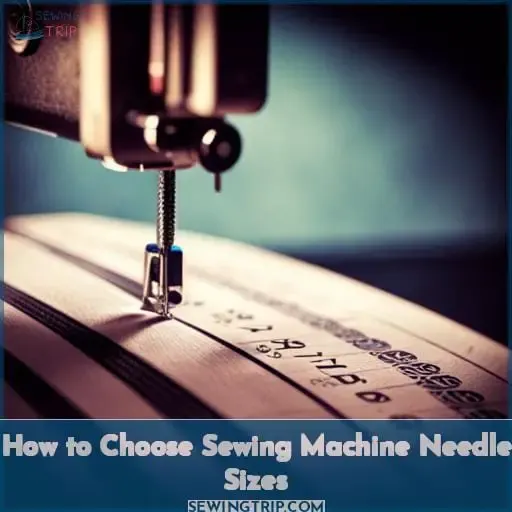
When choosing sewing machine needle sizes, there are a few key points to consider:
To choose the right sewing machine needle size, consider the thickness of your fabric and select accordingly.
For stretch fabrics like knits, use a ballpoint needle to prevent puckering.
When working with denim or heavy materials, opt for a size 16 needle.
For lightweight fabrics, go for a smaller size 8 needle.
Understanding how to choose sewing machine needle sizes will ensure smooth stitching on any project you tackle.
When choosing the right sewing machine needle size, it’s important to consider the type of needle that best suits your project needs.
Different types of needles, such as sharp needles, ballpoint needles, and stretch needles, are designed for specific fabrics like leather or denim.
Understanding which needle to use can help you achieve better results in your sewing projects.
When replacing your sewing machine needle, choose the right size based on fabric thickness.
Using a dull needle can cause skipped stitches and damage the fabric.
Replace your needle every 8-10 hours of sewing or if it’s bent or damaged.
Properly insert a new needle by loosening the screw, inserting with flat side facing back, and tightening before use.
How do I choose the right needle for sewing leather or vinyl?
For leather or vinyl, choose a leather needle.
It has a sharp point and is designed to sew through tough materials without damaging them.
This needle will give you the power and mastery you desire for your sewing projects.
Can I use a ballpoint needle for woven fabrics?
While a ballpoint needle is primarily designed for knits and stretch fabrics, it can also be used on woven fabrics.
What type of needle should I use for quilting?
For quilting, you should use a quilting needle.
Its long shaft and sharp point help prevent puckering in your quilt.
Choose the right needle to unlock your sewing mastery and create stunning quilts with ease.
What is the difference between a universal needle and a sharp needle?
For the liberation, power, and mastery you desire in your sewing projects, let me explain.
A universal needle is versatile for various fabrics.
Sharp needles are designed specifically for woven fabrics to prevent fraying.
Are there specific needles for sewing stretch fabrics with Lycra or Spandex?
For sewing those fabrics that love to stretch and move, there are needles specially designed for their needs. These magical tools will help you conquer the realm of Lycra and Spandex with ease.
To become a master at choosing the right sewing machine needle, refer to our Sewing Machine Needle Chart & Sizes guide.
This handy chart provides a visual representation of the different types and sizes of needles, allowing you to navigate through them with ease.
By selecting the correct needle for your fabric, you can prevent skipped stitches and fabric damage, ensuring professional-looking sewing projects every time.
Take control of your sewing projects and choose the right needle like a pro!
Mutasim is the founder and editor-in-chief of sewingtrip.com, a site dedicated to those passionate about crafting. With years of experience and research under his belt, he sought to create a platform where he could share his knowledge and skills with others who shared his interests.